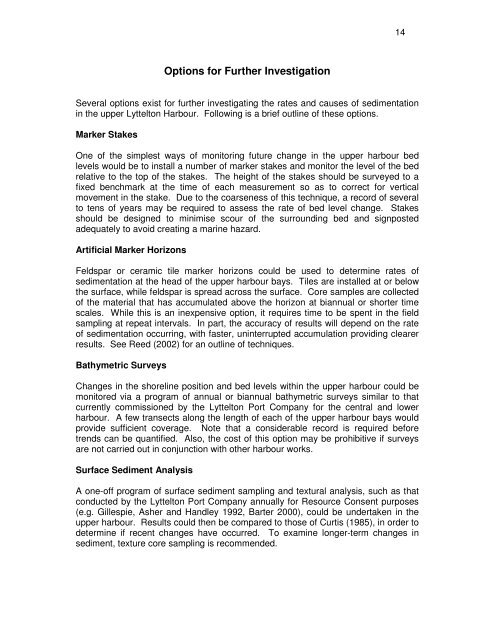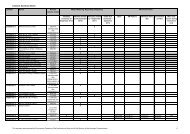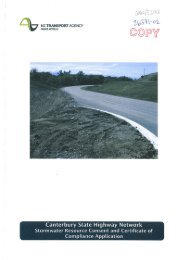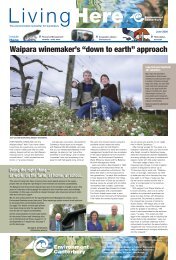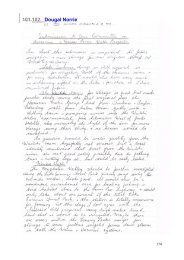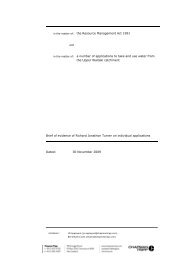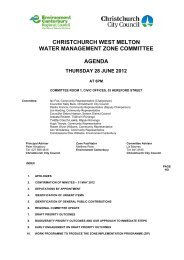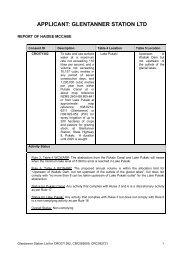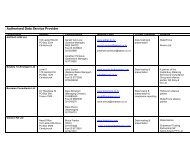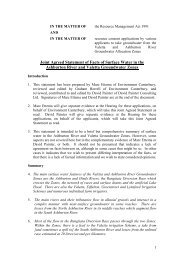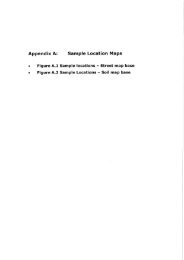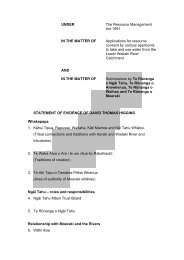Sedimentation in the Upper Lyttelton Harbour - Environment ...
Sedimentation in the Upper Lyttelton Harbour - Environment ...
Sedimentation in the Upper Lyttelton Harbour - Environment ...
Create successful ePaper yourself
Turn your PDF publications into a flip-book with our unique Google optimized e-Paper software.
Options for Fur<strong>the</strong>r Investigation<br />
Several options exist for fur<strong>the</strong>r <strong>in</strong>vestigat<strong>in</strong>g <strong>the</strong> rates and causes of sedimentation<br />
<strong>in</strong> <strong>the</strong> upper <strong>Lyttelton</strong> <strong>Harbour</strong>. Follow<strong>in</strong>g is a brief outl<strong>in</strong>e of <strong>the</strong>se options.<br />
Marker Stakes<br />
One of <strong>the</strong> simplest ways of monitor<strong>in</strong>g future change <strong>in</strong> <strong>the</strong> upper harbour bed<br />
levels would be to <strong>in</strong>stall a number of marker stakes and monitor <strong>the</strong> level of <strong>the</strong> bed<br />
relative to <strong>the</strong> top of <strong>the</strong> stakes. The height of <strong>the</strong> stakes should be surveyed to a<br />
fixed benchmark at <strong>the</strong> time of each measurement so as to correct for vertical<br />
movement <strong>in</strong> <strong>the</strong> stake. Due to <strong>the</strong> coarseness of this technique, a record of several<br />
to tens of years may be required to assess <strong>the</strong> rate of bed level change. Stakes<br />
should be designed to m<strong>in</strong>imise scour of <strong>the</strong> surround<strong>in</strong>g bed and signposted<br />
adequately to avoid creat<strong>in</strong>g a mar<strong>in</strong>e hazard.<br />
Artificial Marker Horizons<br />
Feldspar or ceramic tile marker horizons could be used to determ<strong>in</strong>e rates of<br />
sedimentation at <strong>the</strong> head of <strong>the</strong> upper harbour bays. Tiles are <strong>in</strong>stalled at or below<br />
<strong>the</strong> surface, while feldspar is spread across <strong>the</strong> surface. Core samples are collected<br />
of <strong>the</strong> material that has accumulated above <strong>the</strong> horizon at biannual or shorter time<br />
scales. While this is an <strong>in</strong>expensive option, it requires time to be spent <strong>in</strong> <strong>the</strong> field<br />
sampl<strong>in</strong>g at repeat <strong>in</strong>tervals. In part, <strong>the</strong> accuracy of results will depend on <strong>the</strong> rate<br />
of sedimentation occurr<strong>in</strong>g, with faster, un<strong>in</strong>terrupted accumulation provid<strong>in</strong>g clearer<br />
results. See Reed (2002) for an outl<strong>in</strong>e of techniques.<br />
Bathymetric Surveys<br />
Changes <strong>in</strong> <strong>the</strong> shorel<strong>in</strong>e position and bed levels with<strong>in</strong> <strong>the</strong> upper harbour could be<br />
monitored via a program of annual or biannual bathymetric surveys similar to that<br />
currently commissioned by <strong>the</strong> <strong>Lyttelton</strong> Port Company for <strong>the</strong> central and lower<br />
harbour. A few transects along <strong>the</strong> length of each of <strong>the</strong> upper harbour bays would<br />
provide sufficient coverage. Note that a considerable record is required before<br />
trends can be quantified. Also, <strong>the</strong> cost of this option may be prohibitive if surveys<br />
are not carried out <strong>in</strong> conjunction with o<strong>the</strong>r harbour works.<br />
Surface Sediment Analysis<br />
A one-off program of surface sediment sampl<strong>in</strong>g and textural analysis, such as that<br />
conducted by <strong>the</strong> <strong>Lyttelton</strong> Port Company annually for Resource Consent purposes<br />
(e.g. Gillespie, Asher and Handley 1992, Barter 2000), could be undertaken <strong>in</strong> <strong>the</strong><br />
upper harbour. Results could <strong>the</strong>n be compared to those of Curtis (1985), <strong>in</strong> order to<br />
determ<strong>in</strong>e if recent changes have occurred. To exam<strong>in</strong>e longer-term changes <strong>in</strong><br />
sediment, texture core sampl<strong>in</strong>g is recommended.<br />
14


